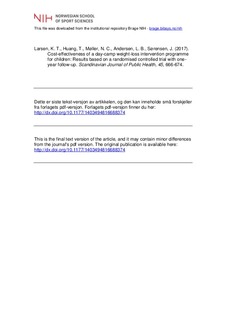| dc.contributor.author | Larsen, Kristian Traberg | |
| dc.contributor.author | Huang, Tao | |
| dc.contributor.author | Møller, Niels Christian | |
| dc.contributor.author | Andersen, Lars Bo | |
| dc.contributor.author | Sørensen, Jan | |
| dc.date.accessioned | 2018-09-20T09:04:32Z | |
| dc.date.available | 2018-09-20T09:04:32Z | |
| dc.date.created | 2017-12-03T20:38:21Z | |
| dc.date.issued | 2017 | |
| dc.identifier.citation | Scandinavian Journal of Public Health. 2017, 45, 666-674. | nb_NO |
| dc.identifier.issn | 1403-4948 | |
| dc.identifier.uri | http://hdl.handle.net/11250/2563579 | |
| dc.description | I Brage finner du siste tekst-versjon av artikkelen, og den kan inneholde ubetydelige forskjeller fra forlagets pdf-versjon. Forlagets pdf-versjon finner du på journals.sagepub.com / In Brage you'll find the final text version of the article, and it may contain insignificant differences from the journal's pdf version. The definitive version is available at journals.sagepub.com | nb_NO |
| dc.description.abstract | Aims: The aim was to analyse the cost-effectiveness of an intensive weight-loss intervention for children compared with a low-intensity intervention. Methods: One hundred and fifteen overweight children (mean age 12.0 ± 0.4) were randomised to either the camp group (CG) (N=59) or the standard group (SG) (N=56). Participants in the CG were offered a six-week day-camp weight-loss programme followed by a family-based supportive programme containing four meetings during the succeeding 46 weeks. Participants in the SG were offered a weekly two-hour exercise session for six weeks. Changes in body mass index (BMI) and BMI z-score 12 months after inclusion were used to compare the effects of the two interventions. Incremental cost-effectiveness ratios (ICER) were estimated from the perspective of a Danish municipality. To achieve the required number of participants, an additional intervention was initiated one year later. Results: In comparison with the SG, the CG changed their mean BMI by −1.2 (95% CI −1.8 to −0.5). Compared with the SG children, the CG children changed their BMI z-score by −0.20 (95% CI −0.35 to −0.05). The ICER per decreased BMI point in the CG compared with the SG was DDK 24,928. Conclusions: Compared with the SG, the CG showed favourable effects after 12 months. However, the CG was more costly. The results observed in the present study may be helpful in guiding decision makers to take more informed decisions when choosing different types of intervention. | nb_NO |
| dc.language.iso | eng | nb_NO |
| dc.subject | childhood obesity | nb_NO |
| dc.subject | cost-effectiveness | nb_NO |
| dc.subject | weight loss | nb_NO |
| dc.subject | intervention | nb_NO |
| dc.subject | physical activity | nb_NO |
| dc.subject | rct | nb_NO |
| dc.subject | incremental cost-effectiveness ratio | nb_NO |
| dc.title | Cost-effectiveness of a day-camp weight-loss intervention programme for children: Results based on a randomised controlled trial with one-year follow-up | nb_NO |
| dc.title.alternative | Cost-effectiveness of a day-camp weight-loss intervention programme for children: Results based on a randomised controlled trial with one-year follow-up | nb_NO |
| dc.type | Journal article | nb_NO |
| dc.type | Peer reviewed | nb_NO |
| dc.description.version | acceptedVersion | nb_NO |
| dc.source.pagenumber | 666-674 | nb_NO |
| dc.source.volume | 45 | nb_NO |
| dc.source.journal | Scandinavian Journal of Public Health | nb_NO |
| dc.source.issue | 6 | nb_NO |
| dc.identifier.doi | 10.1177/1403494816688374 | |
| dc.identifier.cristin | 1522147 | |
| dc.description.localcode | Seksjon for idrettsmedisinske fag / Department of Sport Medicine | nb_NO |
| cristin.unitcode | 150,34,0,0 | |
| cristin.unitname | Seksjon for idrettsmedisinske fag | |
| cristin.ispublished | true | |
| cristin.fulltext | postprint | |
| cristin.qualitycode | 1 | |
